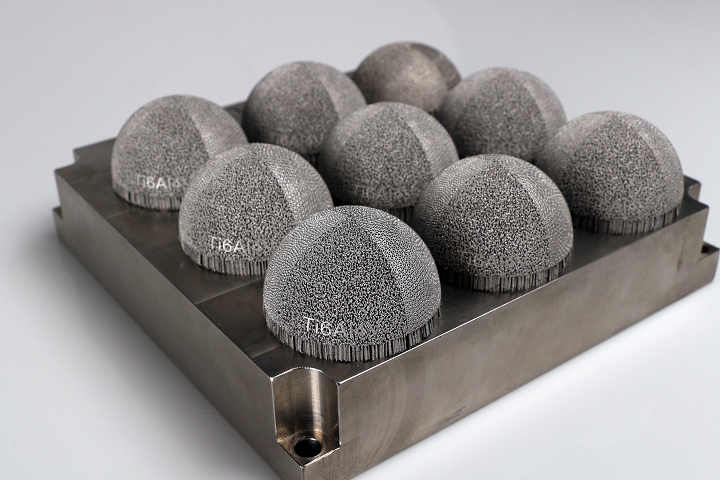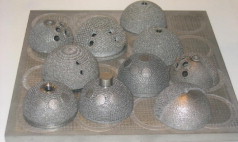In this series, we’ve seen how only a few clusters of 3D printed application implementations have been very successful. We’ve seen how often people in many business development projects stop early as soon as they’ve found a part with one or very few advantages when 3D printed. And we’ve looked in depth at the business case for orthopedics where we discover that there are numerous very important advantages in that application. Orthopedics is the most public application in which we can see evidence of stacking, a 3D printing implementation where very many advantages are stacked atop one another, reinforcing the business case.

Acetabular hip cups
The stacked advantages for 3D printed orthopedic implants include the fact that they:
- Are cheaper than traditionally made counterparts
- Are quicker to iterate and evaluate
- May offer a better product/market fit
- Play well with new software to achieve digital advantages
- Can lead to faster development of new suites of products
- Could result in less expensive group-specific/niche implants
- Provide better osseointegration
- Can approximate the modulus of bone better
- Can reduce mass
- Can be made to expand
- Can demonstrate wicking and other positive features
- Can feature internal structures adapted to better fit
- Can lead to geometry-specific IP
- Could be used to make patient-specific implants
- Make optimal use of expensive materials
- Can be industrialized (expensively)
- Can be upgraded
- Can simplify production
- Fewer parts
Niche Implants
The first five advantages, covered in our previous article on the subject, mean that a company deploying 3D printing at scale could make an implant for a specific group or niche more quickly and easily. So, if a new acetabular cup had to be made for people who were very tall, 3D printed versions could fill this niche. If, for some reason, acetabular cups for small children were a kind of unique application, than it could be profitable for a firm to fill this application. Also, if a supremely specific implant needed to be developed, then a firm could pass the competition, potentially at lower cost, as well.

Osseointegration
Specifically for some implants, osseointegration (bone in-growth( is crucial. We can design and make this an osseointegrating geometry relatively inexpensively through 3D printing. Whats more, we could adapt this geometry quickly if need be. We could even change it for a patient, group of patients, condition, or stage of a disease if need be. This would be much faster because we integrate well with other digital solutions and we require no tooling. Furthermore, our process is uniquely suited to making all manner of geometries very cost effectively. Smooth sucks for us, but porosity we love.
Mimicking Bone
Implants need to be stiff and strong, but not too stiff. Ideally, implants would be made of bone itself, or at least have the same modulus of bone. In that way, there is no stress shearing where the implant wrecks tissue around it. By more closely approximating the modulus of bone, titanium implants can perform as need be and be better for you. Changing the modulus of something is easy with 3D printing and nearly impossible with other technologies. We can make lattices, porous structures, cellular structures or geometry to change properties the necessary properties.
Mass Reduction
Mass reduction or a high strength-to-weight ratio with relatively little material allows you develop small implants that can be easier to implant with less blood loss. This can be an advantage in trauma, unique surgeries and many more cases.
Expanding Parts
3D printing could be used to make structures that can be collapsed for implantation into the body that can then do service as much larger or more functional, expanded structures. I don’t know of a case for this in orthopedics, but in stents and other medical devices, this is something that is seeing a lot of thought. Generally I think that this will really matter in stents and other devices that for example can be done with laparoscopic surgery when collapsed. I’m not sure if this will play a mayor roll in orthopedics.

The Trinity PLUS 2 is a highly porous acetabular cup made with Arcam EBM by the Corin Group.
Wicking Effects
In some cases wicking effects, or structures meant to enhance blood flow to an implant, have been shown to have positive impacts. For 3D printing, such a structure or texture that promotes healthy results can be rather easy to do. Especially when cellular structures, lattices, textures or closed cells are what is needed, this is a great advantage.
Optimized Internal Geometries
In addition to external structures, 3D printing can also adapt a lot of internal geometries, as well as features like crystallinity and internal pathways for example. This kind of modification means that we can also optimize the relevant geometry on the inside of an implant for a specific task.
Geometry as IP
All of this specific geometry, whether it is on the inside or outside of an object, can be protected as IP. You may discover the optimal structure for a Ti-64 implant, which could be patented. Someone else might discover the optimal texture to promote osseointegration. This can be patented also.
Patient-Specific Implants
3D printing can also produce patient specific implants. Even though we think this is a good idea, this may needlessly add complexity or risk. Maybe going from five implant sizes to 20 would be sufficient for 98% of people, and also promote greater safety. On the whole, many believe that this is an advantage and will bring about shorter operations and better patient outcomes. The skeptics, however, are orthopedic surgeons.
Reduced Material Costs
With orthopedics, and in implants in general, the buy-to-fly ratio is important. Materials are very expensive. Also processes, process steps and time in a highly regulated environment is very expensive. Scrap is more of a sin here than elsewhere. So, using less of a material can be a real cost advantage.

EBM-fabricated Ti-6Al-4 V porous mesh pelvic girdle custom manufactured for patient specific polymer T-CAD model (a). (b) Shows the inverted Ti-alloy pelvic insert with arrow indicating attachment for acetabular prostheses for connecting the right leg. From Murr [42]. Courtesy of S.J. Li, Institute of Metal Research, Shenyang, China.
Industrializing for a Lasting Advantage
The industrialization of 3D printing is difficult and expensive. If we all use CNC, we’re all equal in that respect. With 3D printing you could out-maneuver me. What’s more, you can generate higher profitability, innovate faster, develop more process-specific IP, and generally become more competitive if you start earlier and industrialize 3D printing better or more thoroughly than me.
Quick Upgrading
Even though the idea of re-qualifying a material or going through an approval process with a new printer can make people nervous in this business, we do expect significant speed and quality improvements from 3D printing in the coming years. No one is really expecting CNC to become a step-change better.
Simplifying Production
We would also be looking at fewer production steps. Fewer tools. Less integration and different steps. We’ve concentrated our risk on 3D printing as a technology and removed other interdependencies. We would expect fewer steps to lead to an advantage in quality and in making fewer errors.
Fewer Parts
We also have fewer parts and fewer tools, which will lead to us having to keep, make, and preserve these tools less. We’d be faster and have less costs and time when developing new products.
All in all, I think you can see just how powerful stacking advantages can be. In orthopedics, it’s clear that this will bring lasting and decisive advantage to the players that adopt 3D printing. Likewise, your next 3D printing implementation should not look for a likely part but for an application where many AM advantages stack one upon the other to radically change your industry.
Subscribe to Our Email Newsletter
Stay up-to-date on all the latest news from the 3D printing industry and receive information and offers from third party vendors.
You May Also Like
3D Printing News Briefs, April 13, 2024: Robotics, Orthotics, & Hypersonics
In 3D Printing News Briefs today, we’re focusing first on robotics, as Carnegie Mellon University’s new Robotics Innovation Center will house several community outreach programs, and Ugogo3D is now working...
Rail Giant Alstom Saves $15M with 3D Printing Automation Software 3D Spark
3D Spark has entered into a three-year deal with the rail giant Alstom. Alstom, a transport behemoth with annual revenues of $16 billion, specializes in the manufacture of trains, trams,...
Meltio Expands Global Reach with New Partnerships in the Americas and Europe
Spanish 3D printing manufacturer Meltio has expanded its sales network across the globe. With the addition of three new partners in the United States, Brazil, Argentina, and Italy, Meltio aims...
3D Printing Webinar and Event Roundup: April 7, 2024
Webinars and events in the 3D printing industry are picking back up this week! Sea-Air-Space is coming to Maryland, and SAE International is sponsoring a 3D Systems webinar about 3D...































